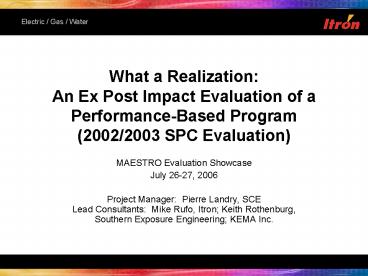MAESTRO Evaluation Showcase - PowerPoint PPT Presentation
Title:
MAESTRO Evaluation Showcase
Description:
requirements for proof of project installation. Knowledge to Shape Your Future. 4 ... PY2002 & PY2003 first years SPC had independent ex post impact evaluation ... – PowerPoint PPT presentation
Number of Views:51
Avg rating:3.0/5.0
Title: MAESTRO Evaluation Showcase
1
What a Realization An Ex Post Impact
Evaluation of a Performance-Based
Program(2002/2003 SPC Evaluation)
- MAESTRO Evaluation Showcase
- July 26-27, 2006
- Project Manager Pierre Landry, SCELead
Consultants Mike Rufo, Itron Keith Rothenburg,
Southern Exposure Engineering KEMA Inc.
2
Overview of Presentation
- Evaluation Context and Background
- Approach
- Results and Key Findings
- Recommendations
3
Context Custom, Bidding, and SPC Type Programs
- History and types
- custom rebates, bidding, SPC
- Goals
- resource acquisition and market transformation
- Common features
- focus on custom efficiency measures in large CI
- encouragement of comprehensive projects
- inclusion of technical engineering review
- requirements for proof of project installation
4
Common Issues for Large CI Programs
- Uncertainty in savings estimates
- Risk of gaming and fraud
- Costs of measurement and verification
- Keeping application requirements manageable yet
effective - Distributing funds equitably
- Minimizing free riders/maximizing net impacts
- Supporting the efficiency services market
5
Background on 2002-2003 CA SPC
- 3 IOUs (PGE, SCE, SDGE)
- Targeted at Large CI
- Incentives by end use
- Lighting (0.05), HVACR (0.14), Process/Other
(0.08) - Calculated or Measured Savings Path
- Determined by utility
- 90 calculated
- All projects require Site Installation Report
6
Why An Ex Post Evaluation of Performance
Contract Program?
- PY2002 PY2003 first years SPC had independent
ex post impact evaluation - Originally (98/99), all SPC projects required
in-program MV - Initially, 2 years of MV, then 1 year
- MT policy environment in CA (1998-2000)
- Virtually no attention to ex post impact
evaluation - MV dropped as requirement in 2000
- Utilities retained right to require
- Most projects done under calculated savings path
- Shift back to resource acquisition focus with
energy crisis and 2006-2008 program admin decision
7
PY2002 SPC Evaluation Objectives and Constraints
- Objectives
- Re-establish process for site-specific ex post
impact evaluation - Implement process for representative sample
- Estimate program realization rate
- Estimate net-to-gross
- Recommendations for improvement
- Constraints
- Total budget vs. program size, project
complexity, of utilities - Per site budgets
- Limited sub-metering
- Took 2 years for most of sample to install
projects - Limited pre-metering available
- Self report NTGR method
8
Approach
- Develop and implement sample design (ratio
estimation) - Obtain files savings documentation
- Review applications and prepare ex post analysis
plans - Conduct on-site data collection (limited
metering) - Develop ex post impact estimates
- Prepare detailed, site-specific documentation
- Carry out quality control review
- Extrapolate final ex post results to the
population - Estimate free ridership
- self-report method
- CADMAC protocol-level battery
9
Population
- Combined 2002-2003 SPC Population (apps)
- Combined 2002-2003 SPC Population (kWh)
10
Sample Design
- PY2002-PY2003 SPC Sample (apps)PY2002-PY2003
SPC Sample (kWh)
11
Gross Realization Rate Results
12
Gross Realization Rate Results
13
Freeridership and Net-to-Gross
DEER SPC NTGR 0.7
14
Key Findings
- PY2002-2003 SPC more like a custom rebate than
performance contract program - Overall realization rate reasonably high but
below one - Wide range in individual realization rates
- Importance of influence of largest projects
- Gross savings may not be as conservative as SPC
program managers intended - NTGR slightly lower than 1998-2001 period
15
Other Savings-Related Key Findings
- Wide range in the quality of applications and
supporting documentation - Need for increased verification and documentation
of assumptions in project files - Experience and expertise levels of the reviewers
vary widely - Difficulties in assessing complex industrial
process projects - Limited estimation of kW peak demand savings
16
Impact-Related Recommendations
- Consider targeted increases in the level of
technical documentation - Consider a stronger application affidavit
statement regarding savings assumptions - Further standardize the review approach and
documentation requirements for recurring complex
projects - Consider providing or requiring more technical
support for applicants for complex projects
17
Savings-Related Recommendations (Cont.)
- Improve reviewer documentation
- Consider increasing
- conservatism for calculated path savings
estimates - measurement for large complex projects
- incentive premium for measured projects
- Increase pre-installation measurement for very
large projects with highly uncertain baseline
conditions - Consider independent review of the SPC calculator
18
Free Ridership-Related Considerations
- Increase efforts to reduce free ridership
- Consider
- Higher incentive levels for higher payback
measures or emerging technologies - Incorporating a payback floor
- Bonus payments for first-time participants
- Custom baselines for process improvements
- Excluding projects that are obvious free riders
19
Evaluation-Related Recommendations
- Consider shifting to ex post impact evaluations
from program-year to paid-year basis - or a combination
- Expand scope of ex post measurement
- more measurement per site
- more sites in samples
- incorporate uncertainty in ex post estimates into
program realization rate confidence interval - Integrate evaluator early into program process to
enable pre-measurement where necessary































